2011高考英语二轮复习课件:专题1 名词和冠词(宁海辽黑专版)
文档属性
| 名称 | 2011高考英语二轮复习课件:专题1 名词和冠词(宁海辽黑专版) | 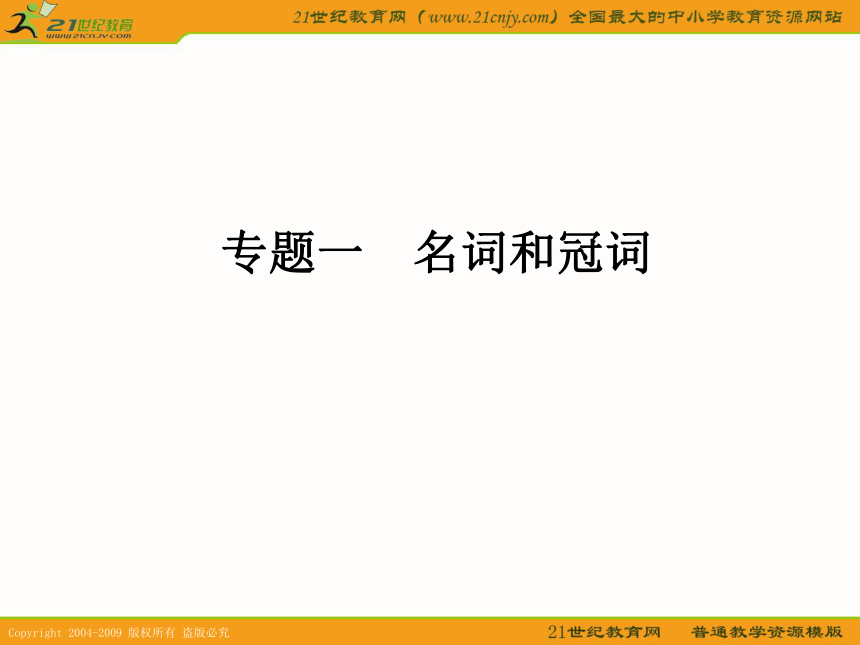 | |
| 格式 | rar | ||
| 文件大小 | 143.4KB | ||
| 资源类型 | 教案 | ||
| 版本资源 | 通用版 | ||
| 科目 | 英语 | ||
| 更新时间 | 2011-01-13 17:11:00 | ||
图片预览

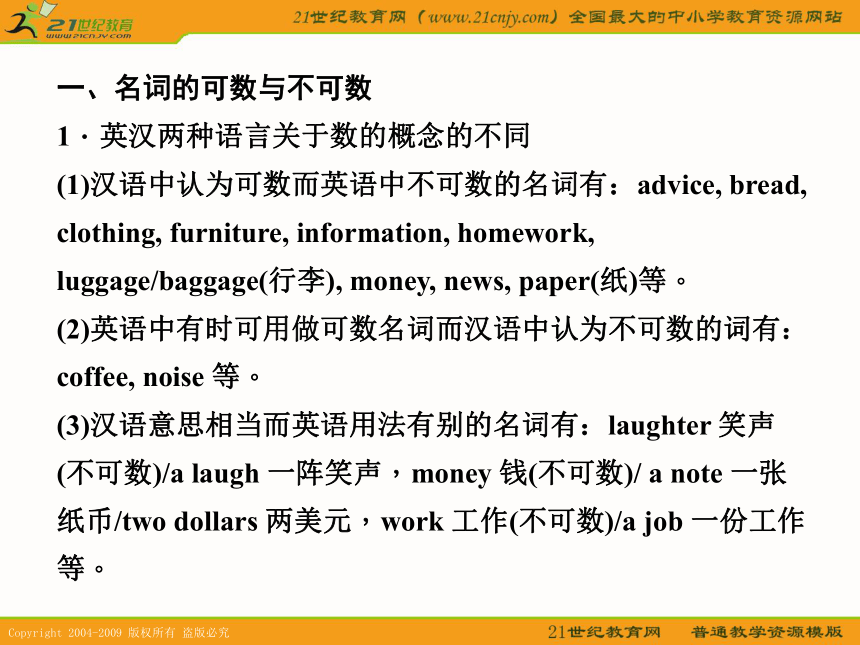
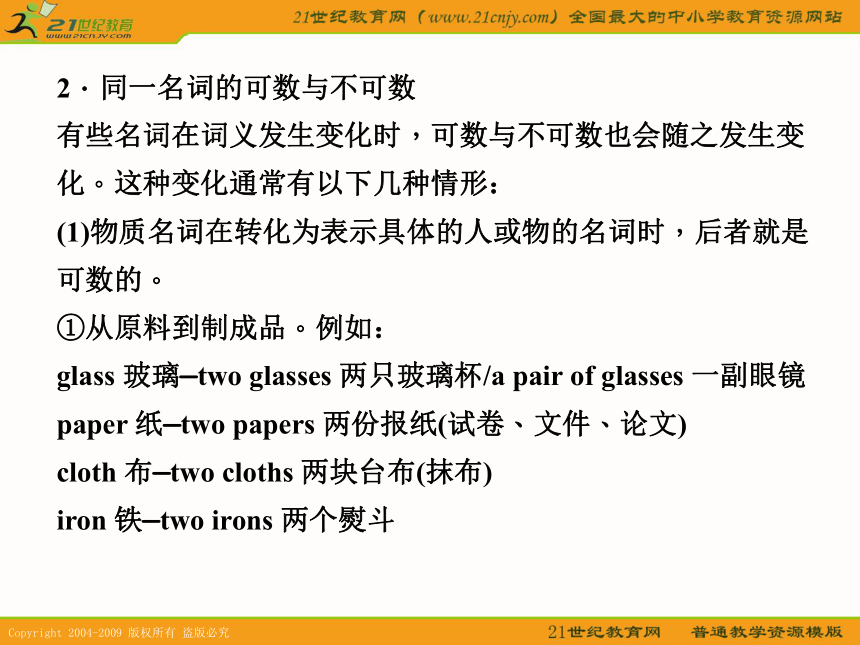
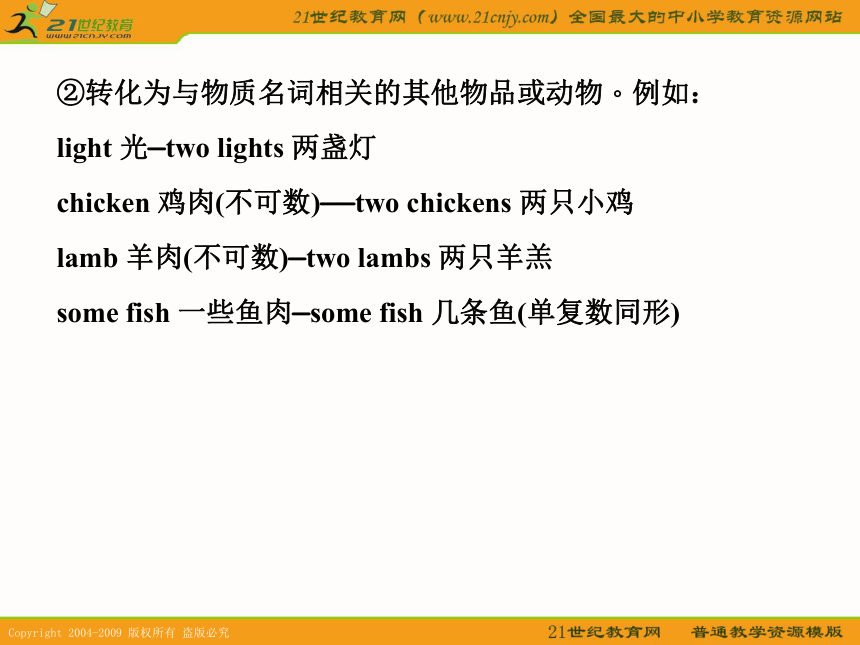

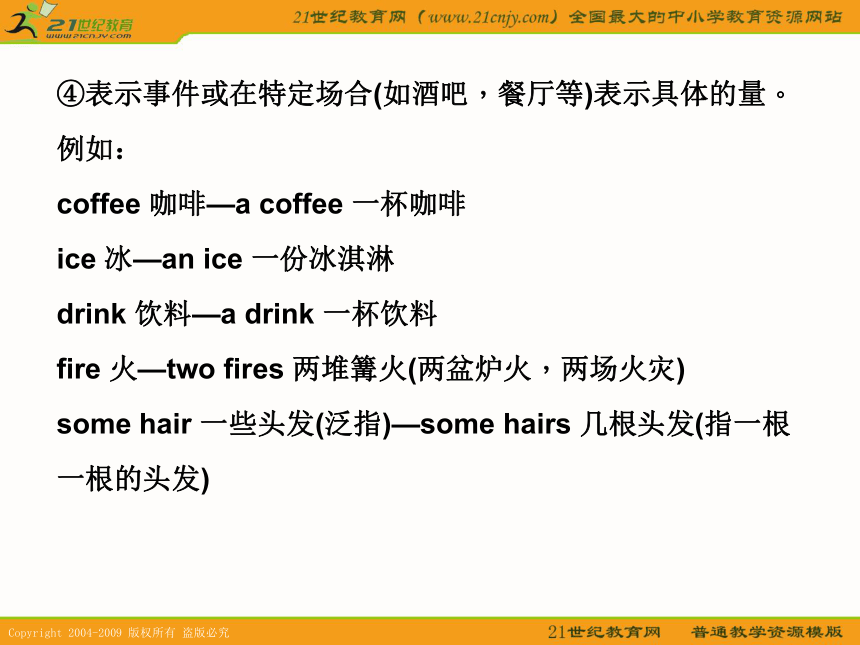


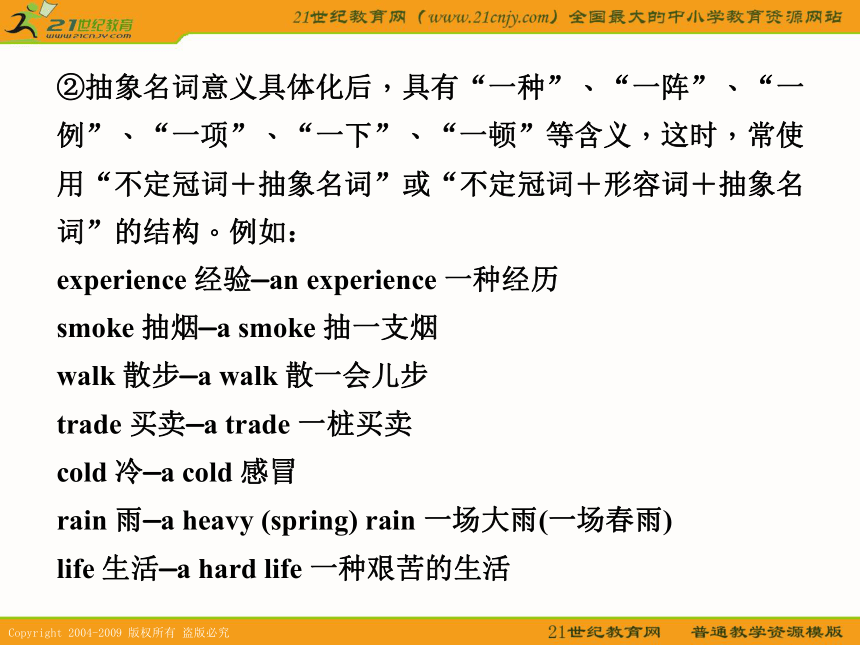


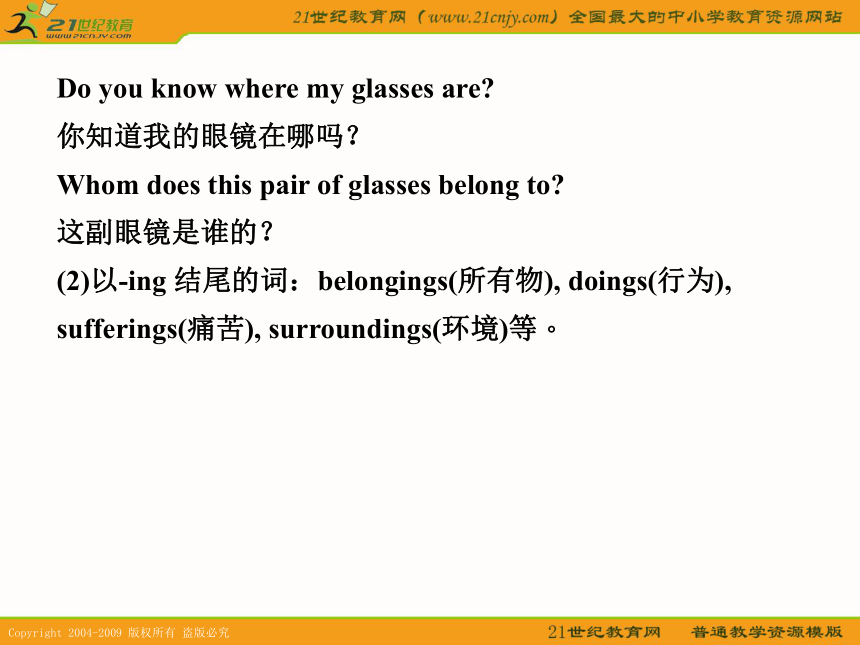
文档简介
课件78张PPT。专题一 名词和冠词
一、名词的可数与不可数
1.英汉两种语言关于数的概念的不同
(1)汉语中认为可数而英语中不可数的名词有:advice, bread, clothing, furniture, information, homework, luggage/baggage(行李), money, news, paper(纸)等。
(2)英语中有时可用做可数名词而汉语中认为不可数的词有:coffee, noise 等。
(3)汉语意思相当而英语用法有别的名词有:laughter 笑声(不可数)/a laugh 一阵笑声,money 钱(不可数)/ a note 一张纸币/two dollars 两美元,work 工作(不可数)/a job 一份工作等。
2.同一名词的可数与不可数
有些名词在词义发生变化时,可数与不可数也会随之发生变化。这种变化通常有以下几种情形:
(1)物质名词在转化为表示具体的人或物的名词时,后者就是可数的。
①从原料到制成品。例如:
glass 玻璃—two glasses 两只玻璃杯/a pair of glasses 一副眼镜
paper 纸—two papers 两份报纸(试卷、文件、论文)
cloth 布—two cloths 两块台布(抹布)
iron 铁—two irons 两个熨斗
②转化为与物质名词相关的其他物品或动物。例如:
light 光—two lights 两盏灯
chicken 鸡肉(不可数)——two chickens 两只小鸡
lamb 羊肉(不可数)—two lambs 两只羊羔
some fish 一些鱼肉—some fish 几条鱼(单复数同形)③表示物质名词的种类。例如:
cloth 布—various cloths 各种布
tea 茶—various teas 各种茶
silk 丝—various silks 各种丝绸
some fruit 一些水果—some fruits 几种水果
some fish 一些鱼肉—some fishes 几种鱼(在现代英语中,some fish 也可表示几种鱼的概念)④表示事件或在特定场合(如酒吧,餐厅等)表示具体的量。例如:
coffee 咖啡—a coffee 一杯咖啡
ice 冰—an ice 一份冰淇淋
drink 饮料—a drink 一杯饮料
fire 火—two fires 两堆篝火(两盆炉火,两场火灾)
some hair 一些头发(泛指)—some hairs 几根头发(指一根一根的头发)(2)有些抽象名词在词义转化后,也可以有复数形式,或者可与不定冠词连用。
①从抽象概念转化为具有某种特性、状态、特点、情感的人、物或事,这时的抽象名词已经完全变成了可数名词。例如:
difficulty 困难—a difficulty 一件难事
surprise 惊讶—a surprise 一件令人惊讶的事
pleasure 愉快—a pleasure 一件乐事
failure 失败—a failure 一位失败者,一件失败的事
success 成功—a success 一位成功者,一件成功的事
wonder 惊奇—a wonder 一个奇迹
beauty 美丽—a beauty 一位美人
law 法律—two laws 两部法规
word 消息—two words 两个单词
some room 一些空间—some rooms 几间屋子②抽象名词意义具体化后,具有“一种”、“一阵”、“一例”、“一项”、“一下”、“一顿”等含义,这时,常使用“不定冠词+抽象名词”或“不定冠词+形容词+抽象名词”的结构。例如:
experience 经验—an experience 一种经历
smoke 抽烟—a smoke 抽一支烟
walk 散步—a walk 散一会儿步
trade 买卖—a trade 一桩买卖
cold 冷—a cold 感冒
rain 雨—a heavy (spring) rain 一场大雨(一场春雨)
life 生活—a hard life 一种艰苦的生活
sleep 睡觉—a short sleep 睡了一小觉
interest 兴趣—a great interest 极大的兴趣
有时,名词也可用复数形式。例如:
exercise 锻炼—exercises 多项运动
③抽象名词有时以复数形式出现,是一种语意强调的说法。例如:thank 感谢 —many thanks 多谢
pity 遗憾—a thousand pities(=a great pity) 非常遗憾
一般来说,不可数名词转化为可数名词时最主要的是下面三种情况:一、物质名词转指具有一定形状的物品时(即物质名词个体化);二、抽象名词具体化时;三、不表示物的具体数量,而只是表示其种类的多寡时。二、名词的单数与复数
1.有些名词总是以复数形式出现。通常有以下几种情况:
(1)由两个部分构成的物品:compasses (两脚规),glasses (眼镜),scissors(剪刀),trousers(裤子),crossroads(十字路口)等。特别提醒:由两个部分构成的事物的名词通常被视为复数,但若前面带有物量词时,其意义是单数还是复数取决于物量词本身。例如:Do you know where my glasses are?
你知道我的眼镜在哪吗?
Whom does this pair of glasses belong to?
这副眼镜是谁的?
(2)以-ing 结尾的词:belongings(所有物), doings(行为), sufferings(痛苦), surroundings(环境)等。
(3)表示数量众多:arms(武器), ashes(骨灰), clothes(衣服), conditions(环境、形势), goods(货物), manners(礼貌), regards(问候), sands(沙滩), spirits(情绪、心情), stairs(楼梯), steps(台阶), things(情况、形势), wages(工资), wishes(祝愿), woods(森林)等。
(4)表示双边关系:make friends with(和……交朋友),change seats with(与……交换座位), shake hands with(和……握手)等。
(5)在一些习惯用语中:make preparations(做准备),make arrangements(做安排),take pains(下工夫)等。
2.以 s 结尾的表示学科的名词,仍然是单数:maths,physics,politics,economics(经济学)等。
3.有些以 s 结尾的名词单、复数都有可能:means(方法),works(工厂、工程、著作、工事)等。
4.dozen,score,hundred,thousand,million 等词表示约数时,其后常加-s,并后接 of,而表示某一确定的数字时,则不能加-s,如:hundreds of people,three hundred people 或 three hundred of the people等(不可说 three hundred of people)。
5.集合名词的数
(1)有些集合名词是不可数名词,它们表示同类事物的总称。这类名词不能用 many,few,而只能用 much,little等来修饰。做主语时,谓语用单数。这类集合名词有:clothing,fruit,furniture,machinery 等。
表示“一个(一件)……”时,可说a piece of...,如:a piece of clothing(一件衣服)。
(2)有些集合名词总是用作复数,与其连用的限定词和谓语动词亦应用相应的复数形式。例如:
These police are on duty,aren‘t they?
这类名词有:people,police,cattle,clothes,staff,youth 等。
特别提醒:要表示其单数时,须用其他词汇,如:a person,a policeman,a cow 等。
(3)有些集合名词,如 audience,class,club,committee,crew,enemy,family,government,group,team,the majority,the public,union 等集体名词,当它们指组成该集体的成员时,应视作复数(但无词形变化),指代它们的代词用 they 或 who;当它们被看做是一个不可分割的整体时,即指“非人格性”单位时,应视做单数,指代它们的代词用it或which。试比较:
The family are all interested in music.They have all decided to go to the concert this evening.
The family,which is a five-good family,consists of two boys and one girl.
三、名词的所有格
1.所有格的句法作用
名词所有格一般表示所有关系,但有时也可以表示主谓、动宾、同位或修饰等关系,如 the city of Beijing 表示的就是同位关系。
2.所有格的基本形式
(1)所有格的基本形式有两种,一是由“名词+‘s”构成,二是由“of+名词”构成。前者多用来表示有生命的东西,后者多用来表示无生命的东西。
如果无生命的事物表示的是时间、距离、自然现象、国家、城市、机构、度量衡等概念时,其所有格也可用“名词+‘s”构成,如:today’s newspaper,five minutes‘ walk,the earth’s atmosphere;China‘s petrol,twenty miles’ journey。
(2)由“名词+‘s”构成的所有格有下面几种情形:
①一般情况下直接在名词后加“-’s”,如:Mr.Li‘s car。
②以 s 或 es 结尾的复数名词只在词尾加“-’”,如:Teachers‘ Day,the workers’club。特别提醒:不是以 s 或 es 结尾的复数名词,仍在词尾加“-‘s”,如:Children’s Day。
③以 s 结尾的专有名词,且词尾读[z]的,可以只在词尾加“-‘”,也可以在名词后加-’s,如:Dickens‘ novels/Dickens’s novels, Engels‘ works/Engels’s works。如果词尾不读[z],则仍在词尾加“-‘s”,如Ross’s seat。
④如果一样东西为两人或多人共有,只在最后一个名词后加“-‘s”,如:the husband and wife’s problems。
如果不是共有,则需在各个名词后分别加上“-‘s”,如:Jack’s and Jim‘s rooms。⑤在表示“店铺”、“某人家”的名词所有格后通常要省掉后面的名词,如:at the doctor’s,in the barber‘s,drop in at his uncle’s,go to Mr.Black‘s。
3.双重所有格
“of+-'s”式所有格修饰前面的名词,这种结构叫做名词双重所有格,用来表示部分概念或感彩。使用双重所有格应注意以下两点: (1)of 前面名词的前面通常要有a,two,any,some,no,few,another 等表示数量的词或this,that,these,those 等限定词修饰,但修饰词不能是the。
(2)of后面的名词必须是指人的名词。不能是指物的,如不可说 a leaf of the book's。 四、不定冠词的主要用法
1.不定冠词 a 置于辅音(而不是辅音字母)开头的单词之前。如:a one-eyed man,a useful method,a European country,a university 等。
不定冠词 an 置于元音(而不是元音字母)开首的单词之前。如:an X-ray machine,an honour 等。例如:
There is an “i” in the word light.
2.当第一次提到某人、某物、某事时,用不定冠词可起介绍作用。例如:
He is a new comer.He is from a large city in Russia.
3.“a(n)+单数可数名词”表示泛指时,可指该类属中的任何一员。例如:
A lamp can give light.灯能发光。特别提醒:“the+单数可数名词”也可以表示泛指,但强调整个类属,而非该类属中的各个成员。例如:
The lamp was invented by Edison.电灯是爱迪生发明的。
4.不定冠词可说明事物的同一性质、特征、程度或大小,表示“相同”的意思,相当于 the same as。例如:
All the children are of an age.所有的孩子都同龄。
The two rooms are of a size.两间房大小一样。
5.不定冠词用于表示时间、速度、价格等意义的名词之前表示“每一”的意思,相当于every。例如:
We usually work eight hours a day.我们每天工作8小时。
6.不定冠词用于人名前,表示说话人对这个人不认识,或表示与某名人有类似性质的人。例如:
A Mr.Li telephoned you just now.有一位李先生刚才打电话给你了。
Everyone wishes to be a Lei Feng in his class.他们班人人都争当雷锋。
7.用于coffee,food,tea,fruit,fog,rain,snow,wind等物质名词前,在表示“一种、一杯、一场”之义时,常用不定冠词。
A heavy rain fell yesterday.昨天下了一场大雨。
I would like a coffee and two beers.我想要一杯咖啡和两瓶啤酒。
8.用于抽象名词前。
I am not sure l‘ll win,but l’ll have a try.不知我能否赢,但我要试试。
Music is really a great pleasure.音乐的确是一种很好的娱乐活动。
9.用于专有名词前。
He is a Chinese and now is working as a doctor in Japan.他是华人,现在在日本当医生。
I remember he came here on a Sunday and left soon.
我记得他某个星期天来过,不过很快就走了。
A John called during your absence.
你不在时一个叫约翰的人来过电话。
10.在同源宾语中,与动词“同源”的名词前一般要加不定冠词。如 dream a sweet dream(做了一个甜美的梦),smile an attractive smile(笑得迷人),die a glorious death(光荣牺牲),sleep a sound sleep(睡得很香)等。
11.不定冠词a或an用于形容词最高级前无比较含义。
He is a most wise man.他是个非常聪明的人。
12.不定冠词a或an用于序数词前,表示“再”。
I need a second cup of coffee.我还需要一杯咖啡。五、定冠词的主要用法
1.“the+集合名词或复数名词”可表示对某一特指的群体作一般性的陈述。例如:
The public(police)wanted to know how serious the situation was.
公众(警察)想知道形势是多么严峻。
2.“the/these/those+形容词”可表示一类人。如:the young,the dead,these wounded,those poor,the living 等。3.前面已经提到过的名词,再度提到时,在前面加 the。
He saw a house in the countryside,far away from the nearest town.He stood outside the house for a while before going in.In the front room there was a fire burning in the fireplace.The room was clean,small and very warm.他在田野里看到一栋房子,房子离最近的城镇也很远。他在房子外面站了一会儿才进去。前面房间的壁炉里燃着炉火。房间干净狭小而温暖。4.表示宇宙中独一无二的事物的名词前加 the,如 sun,earth,moon,world,universe 等。
The earth is bigger than the moon,but it is smaller than the sun.地球比月球大,但是,比太阳小。
5.用于由普通名词构成的国家、党派、巨大建筑、朝代、时代以及江、河、湖、泊、海、洋、运河、海峡、山脉、群岛、报纸、杂志等专有名词前。如 the United States(美国),the United Nations(联合国),the Great Wall(长城),in the 1990s(20世纪90年代),the Ming Dynasty(明代),the Alps(阿尔卑斯山),the Philippines(菲律宾群岛),the Red Sea(红海),the Suez Canal(苏伊士运河),the Sun Moon Lake(日月潭),the Hudson River(哈得逊河),the Yangtze River(长江),the Yellow River(黄河),the Pacific(太平洋),the Himalayan Mountains(喜玛拉雅山脉),the Times《泰晤士报》。 特别提醒:表示独立的岛屿、孤立的山峰的名词前不用冠词。如:Mt.Jade 玉山,Mt.Ali 阿里山,Mount Tai 泰山,Mount E mei 峨嵋山。6.形容词的最高级前、序数词前以及 only,same 前都用 the。
The best student in my class is the shortest boy with the shortest hair.
我班里最优秀的学生是那个最矮的、头发最短的男孩。
Yang Liwei is the first man who has been into space in China.在中国,杨利伟是第一个进入太空的人。
Man is the only animal that can talk.
人是唯一会讲话的动物。
You can stay or leave now;it's all the same to me.
你留下也好,现在就走也好,对我来说都一样。7.演奏乐器时,西洋乐器名称前常用定冠词,但中国乐器的名称前不用定冠词。如:the violin,the piano等。
His grandson plays the violin well.After all,he is only five years old.他的孙子小提琴拉得很好,不过要知道,他只有5岁大。特别提醒:表示课程时前面不用定冠词。例如:
She makes her living by teaching violin.她靠教小提琴为生。8.用于表示在具体的地点、方位,具体的时间或某天的一部分等。
in the world 在世界上
on the moon 在月球上
from the west 从西方
to the right 朝右边
in/at the end 在末尾
in the middle of...在……中间in the country 在乡村
in the east 在东方
on the left 在左边
in/at the beginning 在开始
in the morning 在早晨
in the centre of...在……中央9.“越……越……”的句型中,the 不能省略。
The more careful you are, the fewer mistakes you'll make.你越小心出的错就越少。
10.用于“by+the+计量单位名词”结构中。如 by the pound (按磅),by the foot/yard(按英尺/码),by the hour/day/week/year(按时、日、周、年),by the thousand(成千地)。特别提醒:在表示“按重量计”时,要用 by weight 这一固定短语。 11.“the+表示国籍的形容词”可表示该国全体人民,如:the British,the French,the Swedish,the Chinese 等。 12.“the+姓氏复数”可表示一家人或夫妇二人。例如: The day before yesterday,I called on the Whites,but they happened to be out. 前天我给莱特夫妇打电话,不巧他们出去了。 13.四季名称前一般不加冠词,但在某一年的某一季节前须加定冠词 the。例如: Wang Hai was born in the summer of 1968. 王海生于1968年夏。 表示一年中某一段特定的时间时,也可加 the。例如: Some animals will hibernate(冬眠) through the winter. 一些动物冬季会冬眠。 14.在逢十的年份之前加上定冠词,表示世纪的某个年代。例如: World War Ⅱended in the 1940's.第二次世界大战结束于二十世纪四十年代。 15.在either of,one of 等结构后的名词前须加上定冠词或其他限定词。如:all of the(these/my)students等。 16.在hit sb.on the nose,pull sb.by the arm 这类结构中,不可用物主代词代替其中的定冠词。(现代英语中也可用 hit sb.'s nose,pull sb.'s arm这样的直接说法) 六、不用冠词情况 1.物质名词、抽象名词和专有名词前不用任何冠词。 Money is not everything.金钱不是万能的。 Music can bring people pleasure.音乐可以给人带来快乐。 Philip has lived in China for years.菲利普住在中国多年了。 2.用复数可数名词表示类别泛指,名词前不用冠词。 Young people like to read books.年轻人喜欢读书。 Trees can help clean the air.树木可以帮助净化空气。 3.表示学科、语言的名词前不用冠词。 I like physics though it‘s a bit difficult.尽管物理有点难,我还是喜欢它。 English is one of the most important languages.英语是最重要的语言之一。 特别提醒:表示语言的名词之后有 language 时则要加定冠词。如the English language。 4.星期、月份、节日、假日和三餐前不用冠词。例如: They usually have breakfast at 8 in Britain. 在英国,他们通常早上8点吃早餐。 5.球类活动和游戏活动前不用冠词。例如: He likes playing tennis better than playing chess. 我喜欢打网球而不是下棋。 6.称呼语、家庭成员和家里雇佣的厨师、保姆等名词之前不用冠词。例如: What‘s wrong with me, doctor? 医生,我得什么病了? Ask nurse to take Mother in the open air. 让护士带妈妈去户外。 7.名词前有物主代词、指示代词或不定代词(some,any,no,every,each) 时,不用冠词。例如: Whose dog is that one? 那是谁的狗? I came across my first English teacher this afternoon. 今天下午我碰到我的第一位英语老师了。 A wolf in a sheep‘s skin is our most dangerous enemy. 披着羊皮的狼是我们最危险的敌人。 8.在“单数名词+after(by,in,to)等介词+同一单数名词”(表示“接续”)结构中,名词前不用冠词。如:year after (by) year,step by step,hand in hand,shoulder to shoulder。例如: She made mistake after mistake. 她总是出错。 9.两个并列的形容词最高级修饰同一个名词时,第二个形容词前不用定冠词。例如: He is the tallest and strongest boy in our school. 他是我校最高最壮的男孩。 10.表示职称、头衔的名词在句中作同位语、表语、宾语补足语或主语补足语时,一般不用冠词,作主语、宾语时反之。例如: We made Xu Ting monitor of our class last week. 上周我们选徐婷当班长。 特别提醒:该职称、头衔必须是某一范围独一无二的,否则可加冠词。例:Liu Yun has also been elected a group leader of our class.(组长班上不止一人)刘云也被选为班里的组长。 11.as/though 引导的倒装结构中,如果是名词放于句首,习惯上使用零冠词的单数名词。如: Child as/though she is,she plays the violin perfectly.尽管是个孩子,但她小提琴拉得很好。 12.形容词最高级前有名词所有格或物主代词时,不用定冠词。 A wolf in a sheep‘s skin is our most dangerous enemy. 披着羊皮的狼是我们最危险的敌人。 特别提醒:当两个形容词最高级并列修饰同一个名词时,第二个形容词前通常不用定冠词。如:the shortest and fattest boy 又矮又胖的男孩。 13.no 与 such 连用时应放在 such 之前,such 后的名词不用冠词。 No such thing has ever happened in this village 村子里从未发生过这种事。 14.never,ever置于做主语的名词前,这些名词前不用冠词。 Never did student study so hard.该生从未学得这么刻苦。 15.有些一人兼多个身份的情况,只在第一个名词前使用冠词,其他名词前不再使用冠词。如:a clerk and writer职员兼作家。 16.连系动词 turn 后的名词前一般不加不定冠词。例如: He has turned thief.他成了窃贼。 主语是复数时,表语仍用单数。例如: Later they turned thief.后来他们当了窃贼。 特别提醒:若指不同的人,则每一个名词前都需要使用冠词。如 a clerk and a writer一名职员和一位作家。 七、用冠词与不用冠词的特定情况 1.在 take part in, catch hold of 等短语中,名词前一般不加冠词,但当名词被形容词修饰后,须加不定冠词 a(n)。例如:take an active part in, catch a tight hold of。 替代词 one 的用法亦是如此。试比较: I lost my pen yesterday. I will have to buy one. 我的钢笔丢了,我要买一支。 I lost my pen yesterday. I will have to buy a new one. 我的钢笔丢了,我要买支新的。 2.下列短语中,有无不定冠词,意义不一样: in word(s) 口头上/in a word 总而言之 of age 成年/of an age 同龄 at times 有时,不时地/at a time 一次 in crowds 成群地/in a crowd 在人群中 have words with 争吵/have a word with 与……谈一下 3.在有关场所的名词前,用了冠词就单指具体场所。如果不用冠词,则转指该场所的功能、作用等抽象意义。试比较: in bed (人)睡觉、卧床/in the bed (人)在床上 in office 执政/in the office 在办公室 in prison 坐牢/in the prison 在监狱里 by sea 由海路/by the sea 在海边 at table 在进餐/at the table 在桌旁 at school 在求学中/at the school 在学校 go to college 上大学/go to the college 到大学去 特别提醒:有些短语中用或不用定冠词 the 完全是出于习惯。试比较:go to the office (cinema/theatre/ university)上班(去看电影/去看戏/上大学) go to town 上城/go to the countryside 下乡 in town 在城里/in the city 在城市里 4.下列短语中,有无定冠词,意义不一样: four of us 我们当中的四人/the four of us 我们四人(共有四人) in future 从今以后/in the future 未来,在将来 on earth 到底,究竟,在世界上/on the earth 在地球上,在地面上 of age 成年/of the age 当代,现代 by day 在白天/by the day 按日计 in front of 在……前面(范围以外)/in the front of 在……前部(范围之内) in charge of 负责,管理/in the charge of 由……负责,在……管理下 in course of 正在……过程中/in the course of 当……时候,在……期间 in place of 代替/in the place of 在……地方 八、冠词的位置 冠词一般放在最前面,但在下列情况下,冠词要后置: 1.名词短语中有 many, such, what 等词修饰时,不定冠词要放在这些词的后面。如: many a student, such a clever boy, what a kind man。 2.形容词前有 as, so, too, how, however 等副词修饰时,不定冠词要放在形容词之后,名词之前。例如: He is not so big a fool as you think. 他并不像你想象的那么蠢。 How large a room have you ordered? 你订的房间有多大? 3.不定冠词可以放在副词 quite 和 rather 之前,也可放在它们之后,但必须放在副词 fairly 之前。例如: This is quite a sudden change. 这真是突然的变化。 I think it a rather easy job for you. 我想这工作对你来说太容易了。 Einstein is said to be a fairly good violinist. 据说爱因斯坦的小提琴拉得相当不错。 4.名词短语里如果有 exactly, just, double, twice, half, both, all 等词修饰时,定冠词须放在这些词的后面。如:exactly the same amount, just the person, half the way, twice the length, both the sides 等。[名校模拟演练] 1.(2010·山东潍坊质量监测)I am really a bit worried because I have no idea what my parents' ______ will be to my poor examination result.
A.expresssion B.reaction
C.appearance D.expectation
解析:考查名词辨析。语意为:我真的有点担心,因为我不知道我父母对我不好的考试结果会是什么反应。expression表情;reaction反应;appearance外表;expectation期望。
答案:B2.(2010·安徽皖南八校二联)Our government has decided to give ______ to those environmentally-friendly businesses in many aspects.
A.profit B.interest
C.preference D.advantage
解析:考查名词辨析。profit“利益”;interest“兴趣,嗜好,利息”;preference“偏爱,优待”;advantage“优势,有利条件”。政府已经决定给那些环保的企业多方面的优惠政策。
答案:C3.(2010·长春调研)Finding a girl struggling in the water, he threw himself into the water without ______.
A.hesitation B.suggestion
C.order D.asking
解析:考查名词。发现一名女孩正在水中挣扎,他毫不犹豫地跳入水里。without hesitation“毫不犹豫”,符合题意。
答案:A4.(2010·陕西西安质检)-How do you like the scenery here, Mr Black?
-Wonderful indeed. Beyond all ______, I suppose.
A.explanation B.introduction
C.description D.instruction
解析:考查名词的用法。beyond all description的意思是“无法(用言语)表达”,即这里的景色很美,无法用言语表达。
答案:C5.(2010·石家庄质检)Giving children pocket money as a gift during the Spring Festival is a common ______ in China.
A.sense B.practice
C.deed D.habit
解析:句意:在中国,过春节时给孩子们压岁钱是一个惯例。practice可数名词“惯倒,习惯性的做法”。common sense常识;deed行为;habit习惯。
答案:B6.(2010·河北衡水中学调研)It is well known that knowledge is ______ treasure house, but practice is ______ key to it.
A.a; the B.the; the
C.a; / D./; the
解析:考查冠词的用法。语意:众所周知,知识是宝库,而实践是(开启)宝库的钥匙。前一个空格处是泛指;后一个空格处是特指,指开启宝库的钥匙。
答案:A7.(2010·长春调研)The report said that a bus went out of ______ control on the highway ______ south of the city and rushed into a river.
A.the; the B./; the
C.the; / D./; /
解析:考查冠词。go out of control是固定短语,意思是“失去控制”;“south of...”中的south是方位副词,前面不需要使用冠词。当south用作名词时通常与介词一起使用,如“in the south of...”。
答案:D8.(2010·福建六校三联)What ______ fun talking to you in ______ form of sending e-mails!
A./; the B./; a
C.a; the D.a; /
解析:考查冠词。fun 不可数名词,前面不用冠词;后一空特指发e-mail这种方式,因此用定冠词。
答案:A9.(2010·北京东城期末)Mr Brown works in ______ middle school. It is ______ school built in the 16th century.
A.a; a B.a; the
C.the; a D.the; the
解析:考查冠词的用法。第一空处泛指“一所中学”,用不定冠词a;第二空处仍是泛指,表示“一所创办于16世纪的学校”,仍然用不定冠词,所以选A项。
答案:A10.(2010·北京海淀期末)As we know, ______ Potala Palace, a combination of Tibetan construction art and culture, is considered ______ precious treasure of China.
A.a; a B.the; a
C.the; the D.a; the
解析:考查冠词的用法。第一空处表示“布达拉宫”,是独一无二的专有名词,用定冠词the;第二空表示“中国宝贵的财富”,用不定冠词表示“一种,一样”,所以这里选B项。
答案:B
1.“the+集合名词或复数名词”可表示对某一特指的群体作一般性的陈述。例如:
The public(police)wanted to know how serious the situation was.
公众(警察)想知道形势是多么严峻。
2.“the/these/those+形容词”可表示一类人。如:the young,the dead,these wounded,those poor,the living 等。3.前面已经提到过的名词,再度提到时,在前面加 the。
He saw a house in the countryside,far away from the nearest town.He stood outside the house for a while before going in.In the front room there was a fire burning in the fireplace.The room was clean,small and very warm.他在田野里看到一栋房子,房子离最近的城镇也很远。他在房子外面站了一会儿才进去。前面房间的壁炉里燃着炉火。房间干净狭小而温暖。4.表示宇宙中独一无二的事物的名词前加 the,如 sun,earth,moon,world,universe 等。
The earth is bigger than the moon,but it is smaller than the sun.地球比月球大,但是,比太阳小。
5.用于由普通名词构成的国家、党派、巨大建筑、朝代、时代以及江、河、湖、泊、海、洋、运河、海峡、山脉、群岛、报纸、杂志等专有名词前。如 the United States(美国),the United Nations(联合国),the Great Wall(长城),in the 1990s(20世纪90年代),the Ming Dynasty(明代),the Alps(阿尔卑斯山),the Philippines(菲律宾群岛),the Red Sea(红海),the Suez Canal(苏伊士运河),the Sun Moon Lake(日月潭),the Hudson River(哈得逊河),the Yangtze River(长江),the Yellow River(黄河),the Pacific(太平洋),the Himalayan Mountains(喜玛拉雅山脉),the Times《泰晤士报》。 特别提醒:表示独立的岛屿、孤立的山峰的名词前不用冠词。如:Mt.Jade 玉山,Mt.Ali 阿里山,Mount Tai 泰山,Mount E mei 峨嵋山。6.形容词的最高级前、序数词前以及 only,same 前都用 the。
The best student in my class is the shortest boy with the shortest hair.
我班里最优秀的学生是那个最矮的、头发最短的男孩。
Yang Liwei is the first man who has been into space in China.在中国,杨利伟是第一个进入太空的人。
Man is the only animal that can talk.
人是唯一会讲话的动物。
You can stay or leave now;it's all the same to me.
你留下也好,现在就走也好,对我来说都一样。7.演奏乐器时,西洋乐器名称前常用定冠词,但中国乐器的名称前不用定冠词。如:the violin,the piano等。
His grandson plays the violin well.After all,he is only five years old.他的孙子小提琴拉得很好,不过要知道,他只有5岁大。特别提醒:表示课程时前面不用定冠词。例如:
She makes her living by teaching violin.她靠教小提琴为生。8.用于表示在具体的地点、方位,具体的时间或某天的一部分等。
in the world 在世界上
on the moon 在月球上
from the west 从西方
to the right 朝右边
in/at the end 在末尾
in the middle of...在……中间in the country 在乡村
in the east 在东方
on the left 在左边
in/at the beginning 在开始
in the morning 在早晨
in the centre of...在……中央9.“越……越……”的句型中,the 不能省略。
The more careful you are, the fewer mistakes you'll make.你越小心出的错就越少。
10.用于“by+the+计量单位名词”结构中。如 by the pound (按磅),by the foot/yard(按英尺/码),by the hour/day/week/year(按时、日、周、年),by the thousand(成千地)。特别提醒:在表示“按重量计”时,要用 by weight 这一固定短语。 11.“the+表示国籍的形容词”可表示该国全体人民,如:the British,the French,the Swedish,the Chinese 等。 12.“the+姓氏复数”可表示一家人或夫妇二人。例如: The day before yesterday,I called on the Whites,but they happened to be out. 前天我给莱特夫妇打电话,不巧他们出去了。 13.四季名称前一般不加冠词,但在某一年的某一季节前须加定冠词 the。例如: Wang Hai was born in the summer of 1968. 王海生于1968年夏。 表示一年中某一段特定的时间时,也可加 the。例如: Some animals will hibernate(冬眠) through the winter. 一些动物冬季会冬眠。 14.在逢十的年份之前加上定冠词,表示世纪的某个年代。例如: World War Ⅱended in the 1940's.第二次世界大战结束于二十世纪四十年代。 15.在either of,one of 等结构后的名词前须加上定冠词或其他限定词。如:all of the(these/my)students等。 16.在hit sb.on the nose,pull sb.by the arm 这类结构中,不可用物主代词代替其中的定冠词。(现代英语中也可用 hit sb.'s nose,pull sb.'s arm这样的直接说法) 六、不用冠词情况 1.物质名词、抽象名词和专有名词前不用任何冠词。 Money is not everything.金钱不是万能的。 Music can bring people pleasure.音乐可以给人带来快乐。 Philip has lived in China for years.菲利普住在中国多年了。 2.用复数可数名词表示类别泛指,名词前不用冠词。 Young people like to read books.年轻人喜欢读书。 Trees can help clean the air.树木可以帮助净化空气。 3.表示学科、语言的名词前不用冠词。 I like physics though it‘s a bit difficult.尽管物理有点难,我还是喜欢它。 English is one of the most important languages.英语是最重要的语言之一。 特别提醒:表示语言的名词之后有 language 时则要加定冠词。如the English language。 4.星期、月份、节日、假日和三餐前不用冠词。例如: They usually have breakfast at 8 in Britain. 在英国,他们通常早上8点吃早餐。 5.球类活动和游戏活动前不用冠词。例如: He likes playing tennis better than playing chess. 我喜欢打网球而不是下棋。 6.称呼语、家庭成员和家里雇佣的厨师、保姆等名词之前不用冠词。例如: What‘s wrong with me, doctor? 医生,我得什么病了? Ask nurse to take Mother in the open air. 让护士带妈妈去户外。 7.名词前有物主代词、指示代词或不定代词(some,any,no,every,each) 时,不用冠词。例如: Whose dog is that one? 那是谁的狗? I came across my first English teacher this afternoon. 今天下午我碰到我的第一位英语老师了。 A wolf in a sheep‘s skin is our most dangerous enemy. 披着羊皮的狼是我们最危险的敌人。 8.在“单数名词+after(by,in,to)等介词+同一单数名词”(表示“接续”)结构中,名词前不用冠词。如:year after (by) year,step by step,hand in hand,shoulder to shoulder。例如: She made mistake after mistake. 她总是出错。 9.两个并列的形容词最高级修饰同一个名词时,第二个形容词前不用定冠词。例如: He is the tallest and strongest boy in our school. 他是我校最高最壮的男孩。 10.表示职称、头衔的名词在句中作同位语、表语、宾语补足语或主语补足语时,一般不用冠词,作主语、宾语时反之。例如: We made Xu Ting monitor of our class last week. 上周我们选徐婷当班长。 特别提醒:该职称、头衔必须是某一范围独一无二的,否则可加冠词。例:Liu Yun has also been elected a group leader of our class.(组长班上不止一人)刘云也被选为班里的组长。 11.as/though 引导的倒装结构中,如果是名词放于句首,习惯上使用零冠词的单数名词。如: Child as/though she is,she plays the violin perfectly.尽管是个孩子,但她小提琴拉得很好。 12.形容词最高级前有名词所有格或物主代词时,不用定冠词。 A wolf in a sheep‘s skin is our most dangerous enemy. 披着羊皮的狼是我们最危险的敌人。 特别提醒:当两个形容词最高级并列修饰同一个名词时,第二个形容词前通常不用定冠词。如:the shortest and fattest boy 又矮又胖的男孩。 13.no 与 such 连用时应放在 such 之前,such 后的名词不用冠词。 No such thing has ever happened in this village 村子里从未发生过这种事。 14.never,ever置于做主语的名词前,这些名词前不用冠词。 Never did student study so hard.该生从未学得这么刻苦。 15.有些一人兼多个身份的情况,只在第一个名词前使用冠词,其他名词前不再使用冠词。如:a clerk and writer职员兼作家。 16.连系动词 turn 后的名词前一般不加不定冠词。例如: He has turned thief.他成了窃贼。 主语是复数时,表语仍用单数。例如: Later they turned thief.后来他们当了窃贼。 特别提醒:若指不同的人,则每一个名词前都需要使用冠词。如 a clerk and a writer一名职员和一位作家。 七、用冠词与不用冠词的特定情况 1.在 take part in, catch hold of 等短语中,名词前一般不加冠词,但当名词被形容词修饰后,须加不定冠词 a(n)。例如:take an active part in, catch a tight hold of。 替代词 one 的用法亦是如此。试比较: I lost my pen yesterday. I will have to buy one. 我的钢笔丢了,我要买一支。 I lost my pen yesterday. I will have to buy a new one. 我的钢笔丢了,我要买支新的。 2.下列短语中,有无不定冠词,意义不一样: in word(s) 口头上/in a word 总而言之 of age 成年/of an age 同龄 at times 有时,不时地/at a time 一次 in crowds 成群地/in a crowd 在人群中 have words with 争吵/have a word with 与……谈一下 3.在有关场所的名词前,用了冠词就单指具体场所。如果不用冠词,则转指该场所的功能、作用等抽象意义。试比较: in bed (人)睡觉、卧床/in the bed (人)在床上 in office 执政/in the office 在办公室 in prison 坐牢/in the prison 在监狱里 by sea 由海路/by the sea 在海边 at table 在进餐/at the table 在桌旁 at school 在求学中/at the school 在学校 go to college 上大学/go to the college 到大学去 特别提醒:有些短语中用或不用定冠词 the 完全是出于习惯。试比较:go to the office (cinema/theatre/ university)上班(去看电影/去看戏/上大学) go to town 上城/go to the countryside 下乡 in town 在城里/in the city 在城市里 4.下列短语中,有无定冠词,意义不一样: four of us 我们当中的四人/the four of us 我们四人(共有四人) in future 从今以后/in the future 未来,在将来 on earth 到底,究竟,在世界上/on the earth 在地球上,在地面上 of age 成年/of the age 当代,现代 by day 在白天/by the day 按日计 in front of 在……前面(范围以外)/in the front of 在……前部(范围之内) in charge of 负责,管理/in the charge of 由……负责,在……管理下 in course of 正在……过程中/in the course of 当……时候,在……期间 in place of 代替/in the place of 在……地方 八、冠词的位置 冠词一般放在最前面,但在下列情况下,冠词要后置: 1.名词短语中有 many, such, what 等词修饰时,不定冠词要放在这些词的后面。如: many a student, such a clever boy, what a kind man。 2.形容词前有 as, so, too, how, however 等副词修饰时,不定冠词要放在形容词之后,名词之前。例如: He is not so big a fool as you think. 他并不像你想象的那么蠢。 How large a room have you ordered? 你订的房间有多大? 3.不定冠词可以放在副词 quite 和 rather 之前,也可放在它们之后,但必须放在副词 fairly 之前。例如: This is quite a sudden change. 这真是突然的变化。 I think it a rather easy job for you. 我想这工作对你来说太容易了。 Einstein is said to be a fairly good violinist. 据说爱因斯坦的小提琴拉得相当不错。 4.名词短语里如果有 exactly, just, double, twice, half, both, all 等词修饰时,定冠词须放在这些词的后面。如:exactly the same amount, just the person, half the way, twice the length, both the sides 等。[名校模拟演练] 1.(2010·山东潍坊质量监测)I am really a bit worried because I have no idea what my parents' ______ will be to my poor examination result.
A.expresssion B.reaction
C.appearance D.expectation
解析:考查名词辨析。语意为:我真的有点担心,因为我不知道我父母对我不好的考试结果会是什么反应。expression表情;reaction反应;appearance外表;expectation期望。
答案:B2.(2010·安徽皖南八校二联)Our government has decided to give ______ to those environmentally-friendly businesses in many aspects.
A.profit B.interest
C.preference D.advantage
解析:考查名词辨析。profit“利益”;interest“兴趣,嗜好,利息”;preference“偏爱,优待”;advantage“优势,有利条件”。政府已经决定给那些环保的企业多方面的优惠政策。
答案:C3.(2010·长春调研)Finding a girl struggling in the water, he threw himself into the water without ______.
A.hesitation B.suggestion
C.order D.asking
解析:考查名词。发现一名女孩正在水中挣扎,他毫不犹豫地跳入水里。without hesitation“毫不犹豫”,符合题意。
答案:A4.(2010·陕西西安质检)-How do you like the scenery here, Mr Black?
-Wonderful indeed. Beyond all ______, I suppose.
A.explanation B.introduction
C.description D.instruction
解析:考查名词的用法。beyond all description的意思是“无法(用言语)表达”,即这里的景色很美,无法用言语表达。
答案:C5.(2010·石家庄质检)Giving children pocket money as a gift during the Spring Festival is a common ______ in China.
A.sense B.practice
C.deed D.habit
解析:句意:在中国,过春节时给孩子们压岁钱是一个惯例。practice可数名词“惯倒,习惯性的做法”。common sense常识;deed行为;habit习惯。
答案:B6.(2010·河北衡水中学调研)It is well known that knowledge is ______ treasure house, but practice is ______ key to it.
A.a; the B.the; the
C.a; / D./; the
解析:考查冠词的用法。语意:众所周知,知识是宝库,而实践是(开启)宝库的钥匙。前一个空格处是泛指;后一个空格处是特指,指开启宝库的钥匙。
答案:A7.(2010·长春调研)The report said that a bus went out of ______ control on the highway ______ south of the city and rushed into a river.
A.the; the B./; the
C.the; / D./; /
解析:考查冠词。go out of control是固定短语,意思是“失去控制”;“south of...”中的south是方位副词,前面不需要使用冠词。当south用作名词时通常与介词一起使用,如“in the south of...”。
答案:D8.(2010·福建六校三联)What ______ fun talking to you in ______ form of sending e-mails!
A./; the B./; a
C.a; the D.a; /
解析:考查冠词。fun 不可数名词,前面不用冠词;后一空特指发e-mail这种方式,因此用定冠词。
答案:A9.(2010·北京东城期末)Mr Brown works in ______ middle school. It is ______ school built in the 16th century.
A.a; a B.a; the
C.the; a D.the; the
解析:考查冠词的用法。第一空处泛指“一所中学”,用不定冠词a;第二空处仍是泛指,表示“一所创办于16世纪的学校”,仍然用不定冠词,所以选A项。
答案:A10.(2010·北京海淀期末)As we know, ______ Potala Palace, a combination of Tibetan construction art and culture, is considered ______ precious treasure of China.
A.a; a B.the; a
C.the; the D.a; the
解析:考查冠词的用法。第一空处表示“布达拉宫”,是独一无二的专有名词,用定冠词the;第二空表示“中国宝贵的财富”,用不定冠词表示“一种,一样”,所以这里选B项。
答案:B
